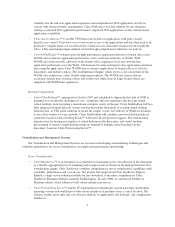Citrix 2007 Annual Report Download - page 21
Download and view the complete annual report
Please find page 21 of the 2007 Citrix annual report below. You can navigate through the pages in the report by either clicking on the pages listed below, or by using the keyword search tool below to find specific information within the annual report.We have a long sales cycle for these enterprise-wide sales because:
• our sales force generally needs to explain and demonstrate the benefits of a large-scale deployment of
our product to potential and existing customers prior to sale;
• our service personnel typically spend a significant amount of time assisting potential customers in their
testing and evaluation of our products and services;
• our customers are typically large and medium size organizations that carefully research their
technology needs and the many potential projects prior to making capital expenditures for software
infrastructure; and
• before making a purchase, our potential customers usually must get approvals from various levels of
decision makers within their organizations, and this process can be lengthy.
The continued long sales cycle for these large-scale deployment sales could make it difficult to predict the
quarter in which sales will occur. Delays in sales could cause significant variability in our revenue and operating
results for any particular period.
We face intense competition, which could result in fewer customer orders and reduced revenues and margins.
We sell our products in intensely competitive markets. Some of our competitors and potential competitors
have significantly greater financial, technical, sales and marketing and other resources than we do. For example,
our ability to market our Application Virtualization products, including XenApp, Access Essentials, Password
Manager and other future product offerings and upgrades, could be affected by Microsoft’s licensing and pricing
scheme for client devices, servers and applications. Further, the announcement of the release, and the actual
release, of new Windows-based server operating systems or products incorporating similar features to our
products could cause our existing and potential customers to postpone or cancel plans to license certain of our
existing and future product and service offerings.
In addition, alternative products for application delivery directly and indirectly compete with our current
product lines and our online services.
Existing or new products and services that provide alternatives to our products and services, including those
relating to application virtualization, server and desktop virtualization Web application optimization, application
performance monitoring, branch office application delivery and WAN optimization, virtual desktop delivery,
secure sockets layers/virtual private network, gateways, on-demand assistance, online collaboration and IP
telephony, can materially impact our ability to compete in these markets.
Our current competitors in these markets include Adobe Systems, Inc., Cisco Systems, Inc., F5 Networks,
Inc., Hewlett-Packard Company, IBM Corporation, Juniper Networks, Inc., Microsoft Corporation, Oracle
Corporation, Riverbed Technology, Inc., Sun Microsystems, Inc., VMware, Inc. and Virtual Iron Software, Inc.
As the markets for our products and services continue to develop, additional companies, including
companies with significant market presence in the computer appliances, software and networking industries,
could enter the markets in which we compete and further intensify competition. In addition, we believe price
competition could become a more significant competitive factor in the future. As a result, we may not be able to
maintain our historic prices and margins, which could adversely affect our business, results of operations and
financial condition.
Sales of products within our Application Virtualization product line constitute a majority of our revenue and
decreases in demand for our Application Virtualization products could adversely affect our results of
operations and financial condition.
We anticipate that sales of products within our Application Virtualization product line and related
enhancements and upgrades will constitute a majority of our revenue for the foreseeable future. Our ability to
15
























